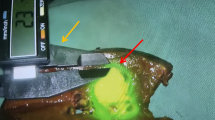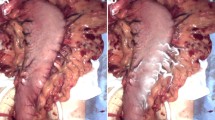Abstract
Background
Photoactive drugs selectively accumulate in malignant tissue specimens and cause drug-induced fluorescence. Photodynamic diagnosis (PDD) and fluorescence can distinguish normal from malignant tissue.
Objective
Methods
From May 2012 to September 2013, a total of 70 patients underwent hepatic resections using 5-ALA-mediated PDD for liver tumors at our hospital.
Results
5-ALA fluorescence was detected in all hepatocellular carcinoma cases with serosa invasion. In liver metastasis from colorectal cancer cases with serosa invasion, 18 patients (85.7 %) were detected, and three patients (14.2 %) whose tumors showed complete response to neoadjuvant chemotherapy showed no fluorescence. Both superficial and deep malignant liver tumors were detected with 92.5 % sensitivity. Using 5-ALA-mediated PDD, tumors remaining at the cut surface and postoperative bile leakage were less frequent than in our previous hepatic resections using conventional white-light observation. Moreover, all malignant liver tumors were completely removed with a clear microscopic margin using 5-ALA, with a significant difference in resection margin width between 5-ALA-mediated PDD (6.7 ± 6.9 mm) and white-light observation (9.2 ± 7.0 mm; p = 0.0083).
Conclusions
With the detection of malignant liver tumors, residual tumor and bile leakage at the cut surface of the remnant liver were improved by PDD with 5-ALA. This procedure may provide greater sensitivity than the conventional procedure. Furthermore, 5-ALA-mediated PDD can ensure histological clearance regardless of the resection margin and preserve as much liver parenchyma as possible in patients with impaired liver function.




Similar content being viewed by others
Abbreviations
- CT:
-
Computed tomography
- MRI:
-
Magnetic resonance imaging
- PDD:
-
Photodynamic diagnosis
- 5-ALA:
-
5-Aminolevulinic acid
- HCC:
-
Hepatocellular carcinoma
- CRCLM:
-
Liver metastasis from colorectal cancer
- PBG:
-
Porphobilinogen
- PBG-D:
-
Porphobilinogen deaminase
- PpIX:
-
Protoporphyrin IX
- FC:
-
Ferrochelatase
- IPN-B:
-
Intraductal papillary neoplasms of the bile duct
- TACE:
-
Transcatheter arterial chemoembolization
References
Fritsch C, Lang K, Neuse W et al (1998) Photodynamic diagnosis and therapy in dermatology. Skin Pharmacol Appl Skin Physiol 11:358–373
Takahashi K, Ikeda N, Nonoguchi N et al (2011) Enhanced expression of coproporphyrinogen oxidase in malignant brain tumors: CPOX expression and 5-ALA-induced fluorescence. Neuro Oncol 13(11):1234–1243
Denzinger S, Burger M, Walter B et al (2007) Clinically relevant reduction in risk of recurrence of superficial bladder cancer using 5-aminolevulinic acid-induced fluorescence diagnosis: 8-year results of prospective randomized study. Urology 69:675–679
Kriegmair M, Baumgartner R, Knüchel R et al (1996) Detection of early bladder cancer by 5-aminolevulinic acid induced porphyrin fluorescence. J Urol 155:105–110
Kriegmair M, Zaak D, Kneuchel R et al (1999) 5-Aminolevulinic acid-induced fluorescence endoscopy for detection of lower urinary tract tumors. Urol Int 63:27–31
Palcic B, Lam S, Hung J, MacAulay C (1991) Detection and localization of early lung cancer by imaging techniques. Chest 103:742–743
Lam S, MacAulay C, Palcic B (1993) Detection and localization of early lung cancer by imaging techniques. Chest 103:12S–14S
Charlesworth P, Truscott TG (1993) The use of 5-aminolevulinic acid (ALA) in photodynamic therapy (PDT). J Photochem Photobiol B 18:99–100
Hinnen P, de Rooij FW, van Velthuysen ML et al (1998) Biochemical basis of 5-aminolaevulinic acid-induced protoporphyrin IX accumulation: a study in patients with (pre)malignant lesions of the esophagus. Br J Cancer 78:679–682
Gahlen J, Prosst RL, Pietschmann M et al (2002) Laparoscopic fluorescence diagnosis for intraabdominal fluorescence targeting of peritoneal carcinosis. Ann Surg 235(2):252–260
Inoue Y, Hayashi M, Komeda K et al (2012) Resection margin with anatomic or nonanatomic hepatectomy for liver metastasis from colorectal cancer. J Gastrointest Surg 16(6):1171–1180
Takayama T, Makuuchi M, Hirohashi S et al (1998) Early hepatocellular carcinoma as an entity with a high rate of surgical cure. Hepatology 28:1241–1246
Webber J, Herman M, Kessel D et al (1999) Current concepts in gastrointestinal photodynamic therapy. Ann Surg 230:12–23
Uchiyama K, Ueno M, Ozawa S et al (2011) Combined intraoperative use of contrast-enhanced ultrasonography imaging using a sonazoid and fluorescence navigation system with indocyanine green during anatomical hepatectomy. Langenbecks Arch Surg 396:1101–1107
Uchiyama K, Ueno M, Ozawa S et al (2010) Combined use of contrast-enhanced intraoperative ultrasonography and a fluorescence navigation system for identifying hepatic metastases. World J Surg 34(12):2953–2959. doi:10.1007/s00268-010-0764-1
Yamashita Y, Hamatsu T, Rikimaru T et al (2011) Bile leakage after hepatic resection. Ann Surg 233:45–50
Ijichi M, Takayama T, Toyoda H et al (2000) Randomized trial of the usefulness of a bile leakage test during hepatic resection. Arch Surg 135:1395–1400
Uchiyama K, Ueno M, Ozawa S et al (2011) Risk factors for postoperative infectious complications after hepatectomy. J Hepatobiliary Pancreat Sci 18:67–73
Loning M, Diddens H, Kupker W et al (2004) Laparoscopic fluorescence detection of ovarian carcinoma metastases using 5-aminolevulinic acid-induced protoporphyrin IX. Cancer 100:1650–1656
Orth K, Russ D, Steiner R et al (2000) Fluorescence detection of small gastrointestinal tumours: principles, technique, first clinical experience. Langenbecks Arch Surg 385:488–494
Zopf T, Schneider AR, Weickert U et al (2005) Improved preoperative tumor staging by 5-aminolevulinic acid induced fluorescence laparoscopy. Gastrointest Endosc 62:763–767
Disclosure
Drs. Y. Inoue, M. Hayashi, R. Tanaka, K. Komeda, F. Hirokawa, and K. Uchiyama have no conflicts of interest or financial ties to disclose.
Author information
Authors and Affiliations
Corresponding author
Rights and permissions
About this article
Cite this article
Inoue, Y., Tanaka, R., Komeda, K. et al. Fluorescence Detection of Malignant Liver Tumors using 5-Aminolevulinic Acid-Mediated Photodynamic Diagnosis: Principles, Technique, and Clinical Experience. World J Surg 38, 1786–1794 (2014). https://doi.org/10.1007/s00268-014-2463-9
Published:
Issue Date:
DOI: https://doi.org/10.1007/s00268-014-2463-9




